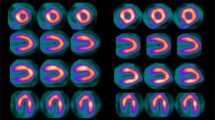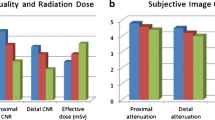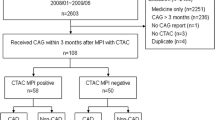Abstract
Background
Obesity is not only associated with an increased risk of coronary artery disease, but also decreases the accuracy of many diagnostic modalities pertinent to this disease. Advances in myocardial perfusion imaging (MPI) have mitigated somewhat the effects of obesity, although the feasibility of MPI in the super-obese (defined as a BMI > 50) is currently untested. We undertook this study to assess the practicality of MPI in the super-obese using a multi-headed solid-state gamma camera with attenuation correction.
Methods
We retrospectively identified consecutive super-obese patients referred for MPI at our institution. The images were interpreted by 3 blinded, experienced readers and graded for quality and diagnosis, and subjectively evaluated the contribution of attenuation correction. Clinical follow-up was obtained from review of medical records.
Results
72 consecutive super-obese patients were included. Their BMI ranged from 50 to 67 (55.7 ± 5.1). Stress image quality was considered good or excellent in 45 (63%), satisfactory in 24 (33%), poor in 3 (4%), and uninterpretable in 0 patients. Rest images were considered good or excellent in 34 (49%), satisfactory in 23 (33%), poor in 13 (19%), and uninterpretable in 0 patients. Attenuation correction changed the interpretation in 34 (47%) of studies.
Conclusions
MPI is feasible and provides acceptable image quality for super-obese patients, although it may be camera and protocol dependent.




Similar content being viewed by others
References
Flegal KM, Carroll MD, Ogden CL, Curtin LR. Prevalence and trends in obesity among US adults, 1999-2008. JAMA 2010;303:235–41.
(WHO) WHO. Obesity: Preventing and managing the global epidemic. Report of a WHO consultation. World Health Organ Tech Rep Ser 2000;894:i-xii, 1-253.
Berger E. Emergency departments shoulder challenges of providing care, preserving dignity for the “super obese”. Ann Emerg Med 2007;50:443–5.
Rao SC, Kusnetzky LL, Lan X, Main ML. Temporal obesity trends in patients undergoing transthoracic echocardiography 2002-2006. Am J Cardiol 2009;103:688–9.
Sturm R. Increases in morbid obesity in the USA: 2000-2005. Public Health 2007;121:492–6.
Kannel WB, Wilson PW, Nam BH, D’Agostino RB. Risk stratification of obesity as a coronary risk factor. Am J Cardiol 2002;90:697–701.
Vinciguerra F, Baratta R, Farina MG, et al. Very severely obese patients have a high prevalence of type 2 diabetes mellitus and cardiovascular disease. Acta Diabetol 2013;50:443–9.
Wilson PW, D’Agostino RB, Sullivan L, Parise H, Kannel WB. Overweight and obesity as determinants of cardiovascular risk: The Framingham experience. Arch Intern Med 2002;162:1867–72.
Hubert HB, Feinleib M, McNamara PM, Castelli WP. Obesity as an independent risk factor for cardiovascular disease: A 26-year follow-up of participants in the Framingham Heart Study. Circulation 1983;67:968–77.
Hu SJ, Liu SX, Katus HA, Luedde M. The value of contrast dobutamine stress echocardiography on detecting coronary artery disease in overweight and obese patients. Can J Cardiol 2007;23:885–9.
McNulty PH, Ettinger SM, Field JM, et al. Cardiac catheterization in morbidly obese patients. Catheter Cardiovasc Interv 2002;56:174–7.
Hansen CL, Woodhouse S, Kramer M. Effect of patient obesity on the accuracy of thallium-201 myocardial perfusion imaging. Am J Cardiol 2000;85:749–52.
Duvall WL, Croft LB, Corriel JS, et al. SPECT myocardial perfusion imaging in morbidly obese patients: Image quality, hemodynamic response to pharmacologic stress, and diagnostic and prognostic value. J Nucl Cardiol 2006;13:202–9.
Robinson CN, van Aswegen A, Julious SA, et al. The relationship between administered radiopharmaceutical activity in myocardial perfusion scintigraphy and imaging outcome. Eur J Nucl Med Mol Imaging 2008;35:329–35.
Taillefer R, DePuey EG, Udelson JE, Beller GA, Latour Y, Reeves F. Comparative diagnostic accuracy of Tl-201 and Tc-99m sestamibi SPECT imaging (perfusion and ECG-gated SPECT) in detecting coronary artery disease in women. J Am Coll Cardiol 1997;29:69–77.
Kang X, Shaw LJ, Hayes SW, et al. Impact of body mass index on cardiac mortality in patients with known or suspected coronary artery disease undergoing myocardial perfusion single-photon emission computed tomography. J Am Coll Cardiol 2006;47:1418–26.
Thompson RC, Heller GV, Johnson LL, et al. Value of attenuation correction on ECG-gated SPECT myocardial perfusion imaging related to body mass index. J Nucl Cardiol 2005;12:195–202.
Gimelli A, Bottai M, Giorgetti A, Genovesi D, Filidei E, Marzullo P. Evaluation of ischaemia in obese patients: Feasibility and accuracy of a low-dose protocol with a cadmium-zinc telluride camera. Eur J Nucl Med Mol Imaging 2012;39:1254–61.
Fiechter M, Gebhard C, Fuchs TA, et al. Cadmium-zinc-telluride myocardial perfusion imaging in obese patients. J Nucl Med 2012;53:1401–6.
Ben-Haim S, Almukhailed O, Neill J, et al. Clinical value of supine and upright myocardial perfusion imaging in obese patients using the D-SPECT camera. J Nucl Cardiol 2014;21:478–85.
Bechlioulis A, Vakalis K, Naka KK, et al. Paradoxical protective effect of central obesity in patients with suspected stable coronary artery disease. Obesity (Silver Spring) 2013;21:E314–21.
Morise AP, Haddad WJ, Beckner D. Development and validation of a clinical score to estimate the probability of coronary artery disease in men and women presenting with suspected coronary disease. Am J Med 1997;102:350–6.
Author information
Authors and Affiliations
Corresponding author
Rights and permissions
About this article
Cite this article
DeCicco, A.E., Sokil, A.B., Marhefka, G.D. et al. Feasibility of SPECT myocardial perfusion imaging in the super-obese using a multi-head semiconductor camera with attenuation correction. J. Nucl. Cardiol. 22, 344–350 (2015). https://doi.org/10.1007/s12350-014-0018-y
Received:
Accepted:
Published:
Issue Date:
DOI: https://doi.org/10.1007/s12350-014-0018-y




